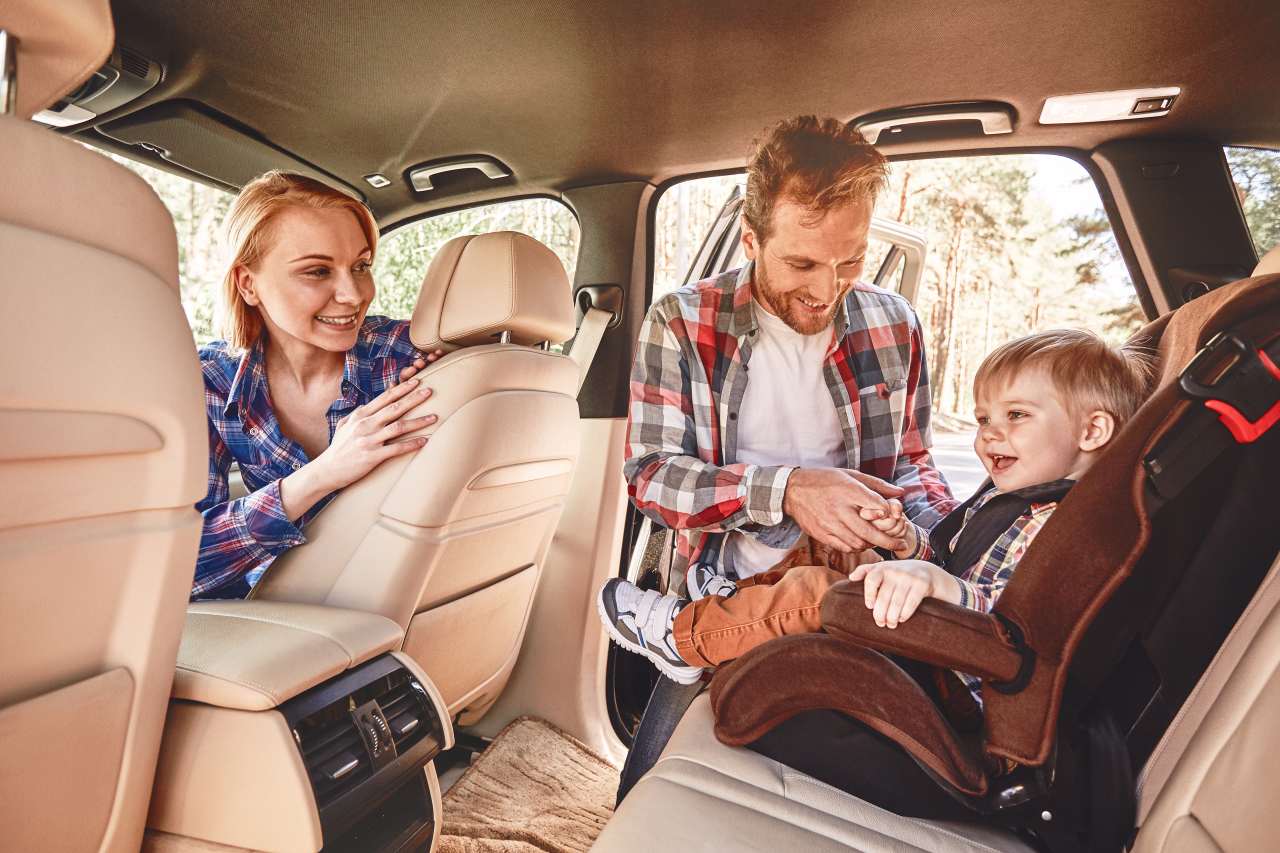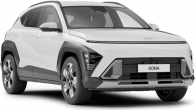Andrew Chesterton is spending three months with the Hyundai Tucson Active X, to see how it suits his family’s needs.
Hyundai Tucson 2020: Active X (2WD) Beige INT
| Engine Type | Inline 4, 2.0L |
|---|---|
| Fuel Type | Unleaded Petrol |
| Fuel Efficiency | 7.9L/100km (combined) |
| Seating | 5 |
| Price From | $20,020 - $25,300 |
| Safety Rating |
|
Part 1: January 15, 2020
We take delivery of our bright blue (Hyundai calls it Aqua, but it's way more eye-piercing and electric than any water I've ever seen. Besides, water is largely free - this paint will cost you $595...) Tucson at the busiest possible time in Australia.
Christmas is right around the corner, then New Year's Eve, and there's a smattering of beach holidays surrounding both. We're talking family visits, freeway slogs, cars filled to bursting. There's no more challenging time for a vehicle in the Chesto household.
And so there wasn't much in the way of getting-to-know-you time with our newest long-term test vehicle, with the Tucson Active X immediately put to work, swallowing bags, parcels and Christmas presents before heading for the freeway in search of beach bliss.
It's here, happily devouring highway kilometres, the car stuffed with food, bags, presents and Australia's most spoiled dog - Poppy the Corgi - that the key selling point of this Tucson becomes pretty obvious.
.jpg)
Above all else, it's easy. Easy to drive, easy to fit lots into, easy to see out of (even when full) and easy to park. In an increasingly complex world, the Tucson reduces almost every drive experience to the absolute basics. Simply point and shoot.
Let me give you an example. Picture a holiday house on the NSW Central Coast. The driveway is one of those steep, narrow types, and so if more than one vehicle is parked out the front of the house, the easiest option is the climb into the one closest to the exit, otherwise much vehicles juggling is required.
Two vehicles were parked in said driveway. One was the Tucson Active X. The other, which shall remain nameless for the moment, was a German brand's attempt at a sporty SUV - one that cost a hell of a lot more than the humble Tucson.
And yet when the German one was parked closest to the exit, we inevitably opted for a complicated car juggle so we could take the Hyundai instead. Sure, the Germanic one is more expensive, and faster, and has better seats and cabin tech. But it was also uncomfortably firm, difficult to see out of and park and an altogether more draining drive experience on anything that isn't a twisting road or racetrack.
The Tucson, on the other hand, was like a well-worn pair of slippers. Easy, comfortable, predictable.
The Active X we're living with occupies the second rung on the Tucson ladder. Below it sits only the entry-level Active ($28,990), and above it lives the Elite (a considerable jump to $42,031), and the top-spec Highlander ($51,007).
The Active X, then, occupies the happy middle ground between cheap and expensive, arriving at $33,990 (drive-away) wth a petrol engine and an automatic gearbox.
That money buys you 18-inch alloy wheels, fog lights and LED DRLs outside, while inside you'll find leather-trimmed seats, an 8.0-inch touchscreen (with Apple CarPlay and Android Auto) that pairs with an eight-speaker Infinity stereo and a digital interface behind the steering wheel.
The engine delivers 122kW and 205Nm, and will happily drink cheaper 91RON fuel, with Hyundai claiming combined fuel use of 7.9L/100km.
The truth, as always, is just a little different. We've averaged 10.6km/100km over our first 1000km of driving - a fairly marginal increase, and one that's made more palatable by the Tucson's penchant for cheap fuel.
That's not to say life has been entirely stress-free with the Tucson, with the top-selling Hyundai serving up some quirks that are taking some time to get used to.
For one, the lack of proximity unlocking is outrageously annoying. The Tucson just happened to arrive at a point where my arms were almost always filled with presents or food or both, and so trying to free the key from my pocket required much Cirque du Soleil antics.
But the biggest issue is the cruise control function. Kudos to Hyundai for including one, but the system fitted to the Tucson can only maintain speed going up hill, not down it, which means you're at serious risk of a speeding fine should you encounter a long downhill run on your journey.
Still, the Tucson has fitted nicely into our family life over its first four weeks. But that month has mostly been filled with long, freeway-based trips. Will that change once we get back to urban life? I'll let you know.
Acquired: December 2019
Distance travelled this month: 1295km
Odometer: 1496km
Average fuel consumption for month: 10.6L/100km
Part 2: March 3, 2020
So we’ve been living with our Tucson for over two months now, with the hard-working Hyundai largely shining at every city-based task it’s been assigned to date.
I’m sure you know the tasks I mean. Just the usual stuff that accompanies a typical Sydney summer: trips to the beach, the shops, the dog park, dodging the apocalyptic ash falling across the entire city as great swathes of our country burned to the ground.

Actually, now that I think about it, it was mostly that last part that kept us confined to suburbia over the past six weeks, with our Tucson marooned on cross-city shuttles without ever getting the chance to really put some kilometres under its belt.
An NYE trip to the Central Coast has proven the only long-distance trip we've don't to date, and as the road there is largely straight and flat, it didn't really test the mettle of the Tucson's metal.
But with February came some desperately needed rain, at once extinguishing the fires and reigniting hope in our rural centres. And struck both by the siren song of the open road, and a desire to spend as much money as we could in towns hurting as they recover from the bushfires, it was at last time to stretch our Tucson’s legs.

Now don’t let the vaguely rugged styling and 172mm in ground clearance fool you. The Tucson - at least in the 2WD, 2.0-litre Active X guise we have here - is more equipped for the urban jungle than it is cross-country adventures.
There is a turbocharged 1.6-litre option, as well as a 2.0-litre diesel power plant, both of which arrive with AWD as standard. But the naturally aspirated petrol engine we’ve got is a strictly two-wheel-drive affair.
The Tucson is more than big enough for our little (two adults, one tiny corgi) family, stretching 4480mm in length, 1850mm in width and 1655mm in height. More important, though, we’re talking a useable 488 litres (VDA) of luggage space with the rear seats in place, swelling to a considerable 1478 litres with the seats folded flat.

To put those numbers into some real-world perspective, we’re yet to drop the rear seats, finding the tall boot storage space big enough to swallow our bags and supplies for a long weekend away without breaking a sweat.
Not breaking a sweat is not always the case with our Tucson, though. Shine though it does on flat freeways, it can begin to feel under-engined on more challenging drives, as though the 2.0-litre engine, good for 122kW and 205Nm, is working hard to shift the Hyundai’s 1.5-tonne weight.
As a result, the six-speed automatic gearbox can come over all fidgety, bouncing between third and fourth gear (or second and third, depending on the incline) as it searches for the optimum power band. It means that, while freeway cruising is a breeze, climbing hills at pace can be mildly infuriating, the gearbox disrupting the peace and quiet in the cabin.

It’s among the few quirks almost literally grinding our gears to date, but it’s also enough to make me think I’d spring for the more powerful 1.6-litre engine, which produces 130kW and 265Nm, and partners with a seven-speed DCT.
While we’re on the subjects of quirks, there’s the lack of proximity unlocking. which, while I’ve never fully appreciated it, I miss it terribly now that I don’t - especially with my arms loaded with bags and groceries. You don’t know what you’ve got til it’s gone, and all that, but it’s put that oft under-appreciated feature high on my must-have list.
So, let’s talk safety kit for a moment. The Active X gets camera-based AEB, Lane Keep Assist, rear parking sensors and the prerequisite reversing camera, but with guidance lines. There’s also ISOFIX attachments in each of the window seats in the back, and three top-tether points across the rear seat. You do miss out on blind-spot monitoring, rear cross-traffic alert and active cruise, but the key stuff is largely covered.
And that pretty much sums up the Active X: the key stuff is largely covered, even if it does without some luxuries.

There’s also a sense of dependability to the way it goes about its business. It’s uncomplicated. Unfussy. And as a result, it feels unbreakable, like there’s not much that can go wrong.
Will that prophecy prove correct? I’ll let you know next month.
Acquired: December 2019
Distance travelled this month: 1475km
Odometer: 2971km
Average fuel consumption for month: 10.1L/100km
Part 3: April, 2020
And so it's come to this, a sad farewell for the Chesto family's Hyundai Tucson Active X, made even sadder by the fact that, owing to our ongoing coronavirus lockdown, it didn't really get used to its full potential over its final four weeks in our care.
A two-week work trip to the USA first cut into my final six weeks with the Tucson, which was followed by two weeks of compulsory coronavirus-killing lockdown on my return.
And by the time that period ended, the entire country was on virtual lockdown, with anything but the most essential of trips ruled out, which meant the Tucson sat still outside my house, a neon-blue reminder of the automotive freedom we'd lost, until it was time to return it.
.jpg)
But that's not to say it didn't get used at all over that period. I've ranted before about how I don't always see the point of mid-sized SUVs, but when a friend of mine put his vintage armchair up for grabs, the Tucson stepped up to the plate, the 488 litres (VDA) of luggage space with the rear seats in place happily swallowing the sizeable chair without me even having to drop the back row, which would have increased the space on offer to 1478 litres.
Part of that, of course, is because the boot opening is so tall, which means you can sit bulky items upright, rather than try and origami-fold them into narrower spaces on off in wagons and hatchbacks. It might not be the key perk of SUV ownership, but when you need it, it matters.
So, how to best summarise my four months with the Tucson? The term trouble-free springs to mind, with the Hyundai attacking all in front of it without so much as breaking a sweat, as at home navigating the tight confines of a shopping centre carpark as it one the open road.
And I think in that lies the real flecks of gold. It might not be the fanciest SUV in the Hyundai stable - or even in the Tucson lineup - what with it's 2.0-litre petrol engine (122kW and 205Nm) that sometimes has to work pretty hard to move the vehicle's 1.5 tonnes and fairly plain interior, but there is also an undeniable sense of dependability on offer here, like the Tucson could push on forever.
We had the car in our possession for a little under four months, and over that time we experienced not one new rattle or squeak, zero mechanical issues to speak of, and, once we'd given it a thorough wash inside and out, it still felt essentially brand new.
And yes, four months isn't a lifetime, but it is an indication of build quality. If you don't believe me, Google the JD Power Initial Quality report, which surveys owners after just 90 days of ownership. Trust me, you'll find plenty of people who've experienced issues not long after taking delivery of a brand new car, no matter the brand.
.jpg)
But there is another term that could be applied to my time with the Tucson, and that is, well, a little unexciting.
Perhaps we expect too much from cars these days if effortless dependability isn't enough to get our pulse racing, but our Tucson - in Active X guise - was a little short on the surprise and delight features.
And so, if it was my money, I'd be spending it on the Tucson Elite, possibly with the 1.6-litre turbocharged engine and seven-speed DCT automatic, which adds niceties like proximity unlocking, push-button start, auto wipers, dual-zone climate control and adjustable driving modes.
I know they seem like small things, but if you read through my earlier dispatches with the Tucson you'll see they do make a difference to your day-to-day life with a car.
And so just like that it's farewell, fair Tucson.
Acquired: December 2019
Distance travelled this month: 95km
Odometer: 3066km
Average fuel consumption for entire period: 10.2L/100km

.jpg)

.jpg)
.jpg)
.jpg)
.jpg)
.jpg)
.jpg)
.jpg)
.jpg)
.jpg)
.jpg)
.jpg)
.jpg)
.jpg)
.jpg)
.jpg)
.jpg)
.jpg)
.jpg)
.jpg)
.jpg)
.jpg)
.jpg)


.jpg)







.png)









.jpg)

.jpg)

